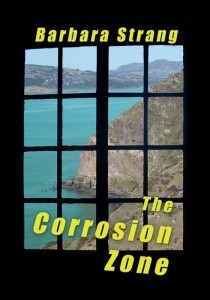Helen Lowe's Blog, page 284
September 23, 2011
Oh No! I Missed "Talk Like A Pirate" Day! But There's Still Great Pirate Tales of SFF …
Avast thar me 'earties—I can't believe I've missed International Talk Like A Pirate Day! September 19 was "the day" and of course that was when I was reflecting on the joys of spring equinox and looking ahead—and so completely missed this Very Important Annual Event.
So I've decided to celebrate it to today, anyway! 
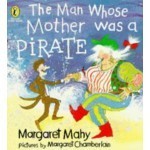 Last year I celebrated by listing some favourite pirate reads, including Margaret Mahy's The Man Whose Mother Was A Pirate, Robert Louis Stevenson Treasure Island, and Rafael Sabatini's Captain Blood.
Last year I celebrated by listing some favourite pirate reads, including Margaret Mahy's The Man Whose Mother Was A Pirate, Robert Louis Stevenson Treasure Island, and Rafael Sabatini's Captain Blood.
Today—and in the spirit of NZ Speculative Fiction Blogging Week—I thought I'd talk specifically about pirate tales in the SFF genre.
 First off the blocks is easy-peasy: it has to be William Goldman's The Princess Bride!
First off the blocks is easy-peasy: it has to be William Goldman's The Princess Bride!
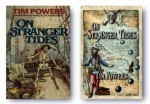 And then there's Tom Powers' On Stranger Tides, which is being used as the basis for the next Pirates of the Caribbean movie. (More Captain Jack Sparrow—not to be confused with the Captain Jack Harkness of Torchwood fame—yes, please! Actually, that would be "yes, please" to both!)
And then there's Tom Powers' On Stranger Tides, which is being used as the basis for the next Pirates of the Caribbean movie. (More Captain Jack Sparrow—not to be confused with the Captain Jack Harkness of Torchwood fame—yes, please! Actually, that would be "yes, please" to both!)
And the classic kids' story, JM Barrie's Peter Pan. And more recently, Kage Baker's The Hotel Under the Sand. (Both of which I mentioned last year—how not?)
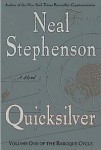 But you know, after that I kind of got to scratching my head, trying to think of SFF books that were specifically about pirates, or featured a main pirate character—not just with a background mention of pirates, as with the Blackbeard incident in Neal Stephenson's Quicksilver, but actually, specifically, about pirates.
But you know, after that I kind of got to scratching my head, trying to think of SFF books that were specifically about pirates, or featured a main pirate character—not just with a background mention of pirates, as with the Blackbeard incident in Neal Stephenson's Quicksilver, but actually, specifically, about pirates.
 I did think about CJ Cherryh's Rimrunners, where former space marine Bet Yeager falls in with a "spook" ship, but that is not quite the same thing as pirates—and although the Earth fleet in Cherryh's "Downbelow" 'verse has effectively taken to behaving like pirates, they don't see themselves as such …
I did think about CJ Cherryh's Rimrunners, where former space marine Bet Yeager falls in with a "spook" ship, but that is not quite the same thing as pirates—and although the Earth fleet in Cherryh's "Downbelow" 'verse has effectively taken to behaving like pirates, they don't see themselves as such …
So you might have to help me out here—what are some other great SFF novels either based specifically around pirates, or featuring a pirate as a major character?
September 22, 2011
More Looking Ahead
On Monday, I was getting into the spirit of spring equinox and looking ahead to what was coming up in the next 6 months—still not fully taking in that daylight saving starts this weekend! And today I got an email asking me to confirm potential dates for a Christmas party—I mean, seriously, a Christmas party … How can it possibly be almost Christmas again, already?!
So as I hadn't got much past October 18 with my looking ahead, I thought I had better extend myself! So here goes …
Well, in 6 months time, The Gathering of the Lost, the second novel in The Wall of Night series, is going to be published in both the USA and UK/AU/NZ. At the moment, the information I have suggests the last week in March for the US and first week in April for the UK/AU/NZ. It doesn't feel quite real at the moment (after all, it's a whole 'nuther equinox away  ) but I am sure it will as I get closer. I'm also sure I will have some covers to show you some time before then—and there is something about having a cover officially "out there" that makes everything seem that little bit more real.
) but I am sure it will as I get closer. I'm also sure I will have some covers to show you some time before then—and there is something about having a cover officially "out there" that makes everything seem that little bit more real.
A whole lot closer in time, in the next month or so I should be doing a couple of guest blog spots on SF Signal-–most likely around epic Fantasy, since that's kinda my thing, but there's a few other ideas floating around out there, too … Anyway, watch this space, because I'll definitely let you know when they're up and running.
Nicole Murphy; photo by Cat Sparks
In the meantime, I'll still be doing my regular first-of-the-month post on the Supernatural Underground —and speaking of which, right now Aussie author Nicole Murphy has an interesting post running there, weighing up the pros and cons, with urban fantasy, as to whether mainstream human society "should" know about the alternate / paranormal beings existing in parallel with them—or not. Click here if you want to weigh in with your own thoughts..
I also hope to be doing more interviews with other writers, similar to the interview with Pip Ballantine and Tee Morris that I posted yesterday, here. Authors I hope to catch up with include Mary Victoria, whose third and final novel in the Chronicles of the Tree series, Oracle's Fire, will be out next month—and possibly Daniel Abraham, to talk about the first in his new epic Fantasy series, The Path of Dragons.
So as I always say, 'watch this space' … But as you can see, there's plenty for me to keep busy with, quite aside from Christmas coming up (like a rocket!) and the ongoing post-earthquake situation here, which is pretty much ubiquitous at present. (And yes, I know, I "should" do another Earthquake Report update—but quite honestly, mostly I'd rather not even talk about it. Just getting through it day-to-day can be tough enough.)
 And don't forget—the Phoenix Rising giveaway as part of the Pip Ballantine/Tee Morris interview will run through until midnight, Sunday 25 (the official end of NZ Speculative Fiction Blogging week.) All you have to do is comment on the interview, here, to go in the draw.
And don't forget—the Phoenix Rising giveaway as part of the Pip Ballantine/Tee Morris interview will run through until midnight, Sunday 25 (the official end of NZ Speculative Fiction Blogging week.) All you have to do is comment on the interview, here, to go in the draw.
September 21, 2011
An Interview with "Phoenix Rising" Co-Authors, Pip Ballantine & Tee Morris—Plus Book Giveaway
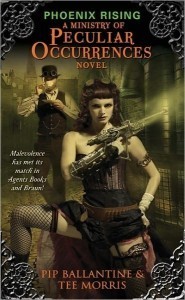 This week is NZ Speculative Fiction Blogging Week, and in the spirit of the week I am delighted to bring you an interview with (New Zealander) Pip Ballantine and Tee Morris, co-authors of Phoenix Rising, the first novel in their "Ministry of Peculiar Occurrences" steampunk series.
This week is NZ Speculative Fiction Blogging Week, and in the spirit of the week I am delighted to bring you an interview with (New Zealander) Pip Ballantine and Tee Morris, co-authors of Phoenix Rising, the first novel in their "Ministry of Peculiar Occurrences" steampunk series.
And Yes—There is A Giveaway!
Pip and Tee are giving away a signed copy of Phoenix Rising, to be drawn from those who comment on the interview before the close of NZ SpecFic Blogging Week on Sunday 25 September. But more giveaway details below the interview!
Now, without further ado, onward to—
The Interview:
Helen: Welcome, Pip & Tee! Firstly, congratulations on Phoenix Rising—A Ministry of Peculiar Occurrences Novel—being nominated for an Airship Award for a Written Work in the Steampunk genre. Is this the first time you've been nominated for a specifically steampunk award?
Tee: Yes, this is our first nomination for a steampunk-specific award; and when we saw that we had made the final cut and the company we were keeping with the category, Pip and I were thrilled.
Pip: We're newcomers to the genre, and we are quite honored to be singled out as outstanding steampunk with all the terrific books that have come out in the past year.
.
Helen: Tell me a little bit about Phoenix Rising—what's it all about?
Tee: Phoenix Rising is a steampunk adventure romp set in a late-Victorian London. In this version of England, amidst the gadgets and the goggles (all of which have practical applications, mind you!), Her Majesty's Ministry of Peculiar Occurrences investigates the strange and the unexplained. Eliza D Braun is a New Zealand secret agent, who through a series of unfortunate explosions, has been demoted to said Archives. The Ministry's chief (and sole) archivist, Wellington Thornhill Books, is most unhappy to have the rather spontaneous Agent Braun in his ordered world. He's happy about being rescued by Agent Braun at the opening of the book, but looks at both her demotion and his new charges as punishment against them both. During her first week or so, Eliza uncovers an unsolved case in the Archives which involves her former partner, and drags Wellington along with her to help solve it—all while trying to hide it from the head of the Ministry.
.
Helen: Steampunk is speculative fiction, but one that draws on an alternate 19th century milieu, effectively imagining continuation of the mechanical age. What drew you both to the subgenre?
Pip: For me it was the chance to twist history, to include characters and places that existed in our world, and make them different—oh and to have a bit of fun!
Tee: For me, it is the subculture of steampunk. I've been fascinated by it ever since two dear friends, J.R. Blackwell and Jared Axelrod, turned me on to it. Steampunk is such a fertile ground for the imagination.
.
Helen: Did you have to do a lot of research to get the Victoriana, and Victorian world, right? And do you think historical accuracy matters in SFF with an historical setting, or it more a case of legitimately using history as a form of broadbrush scene painting?
Pip: I think there is a line where history must give way to the needs of the plot. Where exactly that line is, is up to the individual. We have considerably more wiggle room since what we are doing is set within steampunk, so the ripple effects of steampowered gadgetry and machines has altered a lot of the history. I dare say, when people get to read the sequel, Of Cogs and Corsets, they might find a prominent New Zealand suffragette changed from our reality.
Tee: The history is our basis, of course, but we are not bound by it. We can play within the boundaries of the era. In other words, if I'm doing a "steampunk iPad" I have to make it LOOK like it was built for the time. It's not going to me minimal, but it's going to have finesse, style, and elegance.
.
Helen: Phoenix Rising is a collaboration—what benefits did you find in writing as a team? Were there any difficulties?
Pip: The benefits were definitely more than the difficulties. Having someone to bounce ideas of, someone who might have inspiration when you do not, that constant bouncing back and forth, is delightful. The only challenge can be when you disagree, but sometimes in the process of defending why you want things a certain way you realize that you really don't have a leg to stand on.
Tee: The difficulties are pretty much Pip's doing. She just recently got me hooked on this game for the iPad, Crimson: Steam Pirates. It's awesome … and now my productivity is taking a full broadside.
Seriously though, Pip and I found that writing together is full contact and back-and-forth collaboration. Like ballroom dancing. When I think I'm trying to keep up with Pip, she tells me it's the other way around. We have a lot of fun working together.
Pip: Yeah, but like Ginger Rogers I have to do it backwards and in heels.
.
Helen: And I have to ask: did Tee write the Wellington sequences and Pip the Eliza sections of the book, or did you mix it up a bit?
Tee: That's how it was at the beginning. Eliza was all Pip, and then I brought in Wellington's point-of-view. We also traded off on first drafts of the Interludes. Then, during the editing process, we started to add in our own touches, smooth out transitions, add a few dimensions. The end style was a true hybrid of our individual styles.
Pip: It started off as as simple concept, but became a much more organic process than I was thinking.
.
Helen: Pip, Phoenix Rising's heroine, Eliza D. Braun, is a New Zealander, as are you—how important is it to you to keep a NZ slant on your writing?
Pip: A lot of steampunk is set in either London or the West of America, however Victorian times happened everywhere. Broadening the understanding of the world is not only crucial—it also gives the genre more scope and interest. If we confine ourselves just to England then steampunk as a genre could easily wither on the vine. Tee and I have edited an anthology of Ministry short stories, which are available as digital shorts and podcasts, and many of those were set in places outside of England. Among this collection are two stories actually set in steampunk New Zealand, one by myself and one by Grant Stone, and I like to think we are helping spread awareness of our country.
.
Helen: Steampunk is a very popular form of SciFi-Fantasy (SFF) at present: why do you think that is?
Pip: I think people out there are looking for a sense of optimism, and in the Victorian era, despite all the imperialism and discrimination, there was definitely that. It was the age of the amateur explorer and inventor, and there was a sense that things could get better with technology. Right now, there is a sense of fear among some people about what technology will bring with it.
Tee: Many authors are dismissing steampunk as the flavor of the month. I tend to find those are the authors who are not paying attention to the genre as steampunk has been around since the 80′s. (Also, some of these nay-sayers saying this are writing urban fantasies about hot, sexy female demon-vampire-werewolf slayers who are all bad-ass until that one angel—no pun intended—comes along and rocks their world. But steampunk is trendy!) I think it's appeal comes from its wild abandon into imagination. It can be delightfully fun. It can be dark. Steampunk can be so many things, but indulging your imagination is at its core.
And tea. Don't forget the tea!
.
Helen: How could I possibly forget the tea?! 
"But seriously," Pip and Tee—thank you very much for doing this interview. Just like Phoenix Rising and steampunk itself, it's been a lot of fun and a great feature for NZ Speculative Fiction Blogging Week. I am sure that " … on Anything, Really" readers will enjoy the time with you both as much as I have—and like me, wish you all the very best for the Airship Award!
.
—
Born in Wellington, New Zealand, Philippa has always had her head in a book. For this she blames her father who thought The Lord of the Rings was suitable bedtime reading for an eight year old. At the age of thirteen she began writing fantasy stories for herself.
She first earned a Bachelor of Arts in English Literature and Political Science and then a Bachelor of Applied Science in Library and Information Science. So soon enough she found herself working in the magical world of libraries where she stayed for over a decade.
Her first professional sale was in 1997, and since then she has gone on to produce mostly novel length fiction. In 2006 she became New Zealand's first podcast novelist, and she has voiced and produced Weaver's Web, Chasing the Bard, Weather Child and Digital Magic as podiobooks. Her podcasts have been short listed for the Parsec Awards, and won a Sir Julius Vogel award.
Philippa is the author of the Books of the Order series with Ace- the first of which Geist was released in October 2010. Spectyr (June 2011), Wrayth (2012) and Harbinger are to follow. She is also the co-author of the Ministry of Peculiar Occurrences series with Tee Morris (her soon-to-be husband). Phoenix Rising debuted in May 2011 and Of Cogs and Corsets will be out in 2012. She also has the Shifted World series with Pyr Books, with the first book Hunter and Fox coming in 2012.
When not writing or podcasting, Philippa loves reading, gardening, and whenever possible traveling. Her two Siberian cats, Sebastian and Viola make sure she and the family stay out of trouble.
.
Tee Morris began his writing career in 2002 with his historical epic fantasy, MOREVI: The Chronicles of Rafe & Askana. This Dragon Moon Press title went on to become the first novel to be podcast from cover-to-cover, and one of the founding titles of Podiobooks.com, the premier site for podcast literature.
Tee went on to co-write Podcasting for Dummies and All a Twitter and Sams Teach Yourself Twitter in Ten Minutes, establishing himself as an authority on Social Media matters. His podcasts and blogposts on Facebook, Twitter, Whrrl, and the Social Media movement can be found across the Internet; and have taken him to various speaking engagements around the world including Book Expo America, Te Papa Tongarewa: The Museum of New Zealand, CreateSouth, and LIANZA. He has also written editorial columns for BenBella Books's Farscape Forever: Sex, Drugs, and Killer Muppets and So Say We All: Collected Thoughts and Opinions of BATTLESTAR GALACTICA (co-edited by actor Richard Hatch).
In 2011, Tee returned to his first love—fiction—with Phoenix Rising: A Ministry of Peculiar Occurrences Novel, written with Pip Ballantine. His first major fiction release in nearly three years, the book has already made an impact, being produced as an audiobook within six months of its release; selling rights into Germany, Australia, New Zealand, and Russia; and short-listed for the 2011 Airship Awards for Best Steampunk Work in Literature.
—
[image error]Giveaway Details:
To celebrate NZ Speculative Fiction Blogging Week and the publication of Phoenix Rising in New Zealand, Pip and Tee are giving away a signed copy of Phoenix Rising, to be drawn from those who comment on this interview before midnight, NZ time on Sunday 25 September (the close of NZ SpecFic Blogging Week.) The winner will be drawn by Random Number Generator and posted on Monday 26 at 6.30 am, NZ time.
Please don't forget to check back after the closing date to see if you've won. If the prize has not been claimed by 6.30 am on Wednesday 28 (NZ time), I will re-draw.
.
.
.
September 20, 2011
Celebrating the Seasons In "The Gathering of the Lost"
Today is "officially", I believe, the spring equinox—and I wrote on Monday that it:
" … feels like both a hopeful time, and one to think about what's coming up in the six months ahead."
The arrival of spring equinox also got me thinking about the importance of the seasons and the festivals that mark seasonal transition in The Gathering of the Lost (The Wall of Night, Book Two.)
Over a year ago, in my very first "Influences on Story" post on June 23 (and yes, I know, it's ages since I've done anything on "Influences"—I have been too busy writing m'story, aye!  ) I did mention this, noting particularly that:
) I did mention this, noting particularly that:

Summer's Eve
" Yesterday, the section of The Gathering of the Lost (The Wall of Night Series, Book Two) that I was working on centered around a festival called Summer's Eve, which is "always held on the first new moon of summer."
I then went on to discuss festivals in our world, such as Matariki here in NZ, Valborgsmassafton in Sweden, where I once lived, and May Day in the UK, all of which have influenced my ideas around seasonal festivals and their connection to cultural celebration.
But the seasonal cycle in the Southern Realms of the world of Haarth—which broadly comprise all those lands and kingdoms "from Ij to Ishnapur"—is tied not only to the formality of solstice and equinox, but also to that sense of a shift in the seasons that can come almost overnight, where you step outside and feel the "change" that speaks to you through air and light. For example, the early morning crispness that starts around 20 February (here in NZ), accompanied by a noticeable change in the quality of the light, that tells us that yes, even though autumn equinox is still a month away, the world has already begun its in exorable turn toward winter. And I believe the Japanese celebrate a corresponding turn in mid-late February with the ume matsuri festival, celebrating the plum blossoms that are the first harbingers of spring.

Midsummer Fare
So these are the seasonal celebrations in the Southern Realms of Haarth:
The First of Spring—this takes place approximately eight weeks after the winter solstice, but ahead of the equinox, and celebrates the beginning of spring
Spring Night—spring equinox
Summer's Eve—held approximately half way between the spring equinox and summer solstice, on the first new moon of summer
Midsummer—the summer solstice, usually celebrated by a three day festival
Summer's End—celebrated approximately eight weeks after the summer solstice; also a harvest festival
Autumn's Night—the autumn equinox
Winter's Eve—the last old moon of autumn, marking the advent of winter
Midwinter—the winter solstice
In The Gathering of the Lost, the arc of the story is marked by the passage of these seasonal celebrations, from spring through to summer's end. (And yes, cherries do get a mention in relation to Midsummer … )
September 19, 2011
Tuesday Poem: "Indigo" by Barbara Strang
To achieve the
desired blue
the cloth had to
be lifted in
and out of the vats
in the heat
of India, Nigeria
or Thailand.
Indigo – you used
to wear that deep-dyed hue,
it suited you.
The name for the
spectral blue-violet.
Indigo
a blue as
deep as your eyes,
the lashes a flight of geese
on the last stripe of blue as the
sky plunges towards night.
.
(c) Barbara Strang
from The Corrosion Zone, HeadworX, 2011
Indigo is reproduced here with the permission of Barbara Strang.
—
Opening up The Corrosion Zone for the first time was one of those moments of mixed hesitation and anticipation—because although the collection, Barbara's second, is new, I knew that I had already encountered several of the poems as works-in-progress when we were both part of the Friday Group (aka "the Boiler House.") I had also heard others read as part of the Canterbury Poets' Collective's regular autumn season. So the hesitation was because I feared over-familiarity, the anticipation because I know just how good a poet Barbara is.
Well, that hesitation was gone as soon as I immersed myself in the poems. Yes, several are familiar, but Barbara (not surprisingly!) has revised and polished them since I first encountered them, lifting the poems to the higher level I expect in a HeadworX publication. And there is a great deal in The Corrosion Zone that was completely new to me, including a fine sequence of poems around Barbara's brother, Andrew, who committed suicide several years ago. Other poems centre around the break up of Barbara's marriage and the major transition that involved, both physically, with the loss of one home and move to another, and also emotionally. Yet despite these profound emotional shifts the collection is not indulgent, but spare, wry, and poignant in its understated reserve.
The Corrosion Zone also includes some very fine poetic turns of phrase, such as the culminating stanza of Indigo:
" …
the lashes a flight of geese
on the last stripe of blue as the
sky plunges towards night."
.
Oh, yes: thank you, Barbara.
—
About the Poet:
Barbara Strang's first poetry collection Duck Weather (Poets Group) was published in 2005, when John O'Connor described Barbara as "a significant new voice in New Zealand poetry."
Barbara won the Aoraki Festival Contest in 1998, the NZ Poetry Society's International Haiku Competition in both 2003 and 1997, and the Takahe Cultural Studies Competition 2002 for her essay on James K Baxter. She is currently editor for Sudden Valley Press and was guest editor for the NZ Poetry Society's 2009 and 2010 anthologies. Barbara has an MA in Creative Writing from the Institute of Modern Letters, Victoria University of Wellington (1998) and lives at McCormack's Bay in Christchurch, New Zealand.
September 18, 2011
Looking Ahead
This week we're already in our southern hemisphere spring equinox—over the days of Tuesday 20 and Wednesday 21 September—and that feels like both a hopeful time, and one to think about what's coming up in the six months ahead.
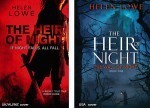
"Daughter of Blood"---let the writing begin!
Daughter of Blood
Firstly and most importantly for me, I've begun work on Book Three in The Wall of Night series, working title Daughter of Blood. I've had the prologue in my mind for some years, almost from the beginning of writing The Heir of Night, as well as the ending and a good idea of the story arc in between. But last week the beginning of the the first chapter beyond the prologue came to me, so I knew it was "time to begin." So far I haven't put pen to paper—or fingers to keyboard either  —in a narrative sense, but what I am doing is going through The Gathering of the Lost and picking up all the story threads that I need to have in my mind as I begin to write, and getting them into one document that I can keep referring back to.
—in a narrative sense, but what I am doing is going through The Gathering of the Lost and picking up all the story threads that I need to have in my mind as I begin to write, and getting them into one document that I can keep referring back to.
I know it may sound a little dull, but for me as the author it's actually quite exciting, because what I am dealing with is possibility, that sense of the paths of the story opening out, and believe me, that is quite deliciously exciting! 
.
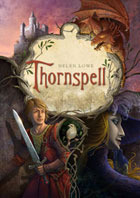 A Thornspell Short Story—about Rue!
A Thornspell Short Story—about Rue!
Also on the "to do" list is writing a short story about Rue, set in the Thornspell 'verse—as a result of the "Fun with Thornspell" competiiton that was decided last week, here. I am actually very excited about this and already have some ideas percolating—and don't forget it'll be published right here on the blog, probably in a month to six weeks time. Writing it won't take that long, but I always feel it's best to give the story some downtime before coming back to it and revising into a second draft. So I'm giving myself that time, with apologies if it seems a bit of a wait for 'just a short story.'
But you see, I have this theory about short stories, which is that they are as much their own literary form as a poem or a novel, and getting them 'right', so that the tale being told works as a short story—well, that's not as easy as you might think.
.
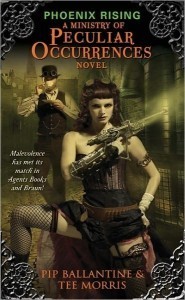 An Interview with Pip Ballantine and Tee Morris About Their Newly Released Steampunk Novel: Phoenix Rising-–A Ministry of Peculiar Occurrences Novel
An Interview with Pip Ballantine and Tee Morris About Their Newly Released Steampunk Novel: Phoenix Rising-–A Ministry of Peculiar Occurrences Novel
This week is NZ Speculative Fiction blogging week, and all going well I hope to bring you an interview with our own NZ author abroad, Pip Ballantine, and also Tee Morris (well known to many here in NZ, as well as his home USA) whose Ministry of Peculiar Occurrences steampunk novel, Phoenix Rising, was recently released in NZ. But if not this week, it should still be "soon." 
.
Christchurch Friends of the Library Talk on Tuesday 18 October
You may recall that I recently spoke as part of the Writers' Tea Party at the Hurunui Memorial Library in Amberley, which I reported on here—and coming up I have another library event, this time as a guest of the Christchurch Friends of the Library at the South library in Beckenham on 18 October.
I understand the event starts at 12.15 pm and is open to all, for a gold coin entry charge.
.
And there may be another "Looking Ahead" just a little later in the week. 
September 17, 2011
Just Arrived: "The Language of Flowers" by Vanessa Diffenbaugh & "The Quantum Thief" by Hannu Rajaniemi
Two new books arrived this week.
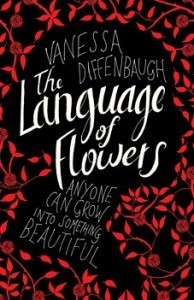 First through the door was an uncorrected proof copy (aka ARC) of The Language of Flowers by debut author Vanessa Diffenbaugh. There's a bit of "buzz" about this book and here's what it says on the back:
First through the door was an uncorrected proof copy (aka ARC) of The Language of Flowers by debut author Vanessa Diffenbaugh. There's a bit of "buzz" about this book and here's what it says on the back:
"The Victorian language of flowers was used to convey what words could not, from declarations of love to confessions of betrayal … The Language of Flowers is a heartbreaking and redemptive novel about the meaning of flowers, the meaning of family, and the meaning of love. Beautiful, original and utterly unforgettable, it is set to be the fiction sensation of 2011."
Needless to say, I am looking forward with interest to the read.
—
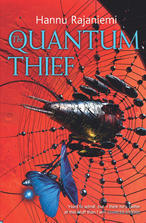 The Quantum Thief by Finnish author, Hannu Rajaniemi, is another book that comes with a bit of buzz, including a glowing recommendation from UK SF author, Charles Stross: "The best first SF novel I've read in years."
The Quantum Thief by Finnish author, Hannu Rajaniemi, is another book that comes with a bit of buzz, including a glowing recommendation from UK SF author, Charles Stross: "The best first SF novel I've read in years."
And the back cover says:
"Jean le Flambeur is a post-human criminal, mind burglar, confidence artist, and trickster … Now … condemned to play endless variations of a game-theroretic riddle in the vast virtual jail … against countless copies of himself … A dazzling hard SF novel set in the solar system of the future — powered by very human motives of betrayal, revenge and jealousy."
—
Two very different books, but I am looking forward to giving both a go.
How about you? What's new on your TBR list?
September 16, 2011
A Dutch Review for "Kind van de Nacht" (The Heir of Night)
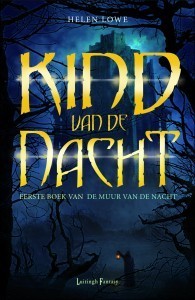 Marion, the translator for Kind van de Nacht, the Dutch language edition of The Heir of Night, has sent through a link to "a positive Dutch review, posted on a big book lovers blog" (as follows):
Marion, the translator for Kind van de Nacht, the Dutch language edition of The Heir of Night, has sent through a link to "a positive Dutch review, posted on a big book lovers blog" (as follows):
http://www.ezzulia.nl/forum/viewtopic.php?f=6&t=8243
Marion also advises that:
"Roughly translated it says:
'Kind van de Nacht' turned out to be hard to put down. Not just its world but also the structures of the people to which the young heroine belongs and several other ones are convincingly portrayed, as is the enemy. The author also knows how to build up the tension. In short, it's a gem to read. Roll on the next books.
Or, as Google Translate puts it:
Child of the Night was a difficult way to explain the world but also the structures of the people where the young heroine belongs, and some others have convincingly put down and so are the enemy. In addition, the author knows how to deal with tension, in short, a gem and let the reading continue coming."  (I added the wink, not Marion, btw!)
(I added the wink, not Marion, btw!)
But that's a very cool review—thank you so much, Marion, for sending it through and for the translation!
Go Kind van de Nacht!
September 15, 2011
Reflections on What I'm Reading
Sometimes, when you're reading, particular lines leap out at you.
Perhaps because of the year we've been having here in Christchurch, with the earthquakes (you can read some of my reports here and poems here); or reflecting on the 10th anniversary of the collapse of the Twin Towers in New York on September 10, 2001, and the legacy of that event a decade later; or just taking two seconds to consider the world around me (famine again in the horn of Africa, kidnappings and murder in Kenya, oil still not contained in the Gulf of Mexico, the spectre of global financial crisis) the following lines have all resonated for me in recent reading:
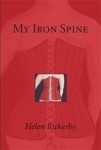 From Helen Rickerby's poem Vital Melancholy in her collection My Iron Spine (Headworx, 2008):
From Helen Rickerby's poem Vital Melancholy in her collection My Iron Spine (Headworx, 2008):
Two nights ago
driving the storm road
beside the lake
I realised I was afraid
Now knowing that the world
is frightening
for children because
they don't understand it
and frightening for grown-ups
because they do
.
 I also read Fannie Flagg's Fried Green Tomatoes at The Whistle Stop Cafe recently (saw the movie years ago, but only just read—and also enjoyed—the book!) and was struck by the following lines:
I also read Fannie Flagg's Fried Green Tomatoes at The Whistle Stop Cafe recently (saw the movie years ago, but only just read—and also enjoyed—the book!) and was struck by the following lines:
" … He had seen a lot happen at the mission … seen [men] … down on their luck … He had seen men come through that had been rich doctors and lawyers, and one man who had been a state senator … Smokey asked Jimmy what caused men like that to sink so low. "I'd have to say the main reason is that most of them have been disappointed in some way," Jimmy said, "… and so they get lost and wander around. And, of course, old man whisky plays a role. But in all the years I've seen men come in and out, I'd say disappointment is number one on the list."
.
This quote from Fried Green Tomatoes reminded me of poet and doctor Glenn Colquhoun's speech on "The Therapeutic Uses of Ache" to the Royal College of General Practitioners in Wellington in 2009, where he observed:
"In fact, apart from a few of the old favourites, I don't often see much of what I learnt about in medical school at all … Of all the conditions I do see that no one ever taught me about, ache is by far and away the most common. Too often in my practice it has forced me to leave the tar-seal of the textbook. At those times I have returned to what I have learnt from life by living it, mainly from making a hash of it. It is the most reliable source of ache I know … Over time our sorrows accumulate. Ache becomes part of our shape – a weird anatomy. It can be felt, seen, perceived and mapped by those who know its language. "
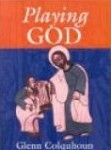 To read the full address, click here: it's well worth it and also reminded me all over again what an acute observer Glenn Colquhoun is and how I need to read his collection Playing God again, and maybe even share some of the poems with you of a Tuesday.
To read the full address, click here: it's well worth it and also reminded me all over again what an acute observer Glenn Colquhoun is and how I need to read his collection Playing God again, and maybe even share some of the poems with you of a Tuesday.
.
For me, writing is primarily to tell the stories that are "out there" in the realm of imagination, wanting and waiting to be told in the world. But within and through that come other things: to illuminate the human condition, to explore truths, to understand why we are and how … Literature, whether engaged in as writer or reader, is about connection, the realisation that we are part of a greater whole; and also reflection—holding up a mirror to ourselves, which very often shows us Glenn Colquhoun's "ache."
.
And to finish, a quote that has long been a favourite of mine, from that very prolific writer, Aurelius Augustine, aka St Augustine of Hippo:
"Bad times, hard times, this is what people keep saying; but … we are the times: Such as we are, such are the times."
September 14, 2011
"Fun With Thornspell": We Have A Result!
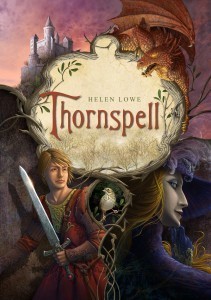 On August 1 I began "Fun with Thornspell", in which I asked readers to tell me the Thornspell character they would most like to have a standalone short story written for, or about—as well as why, based on that character's exploits in the Thornspell story.
On August 1 I began "Fun with Thornspell", in which I asked readers to tell me the Thornspell character they would most like to have a standalone short story written for, or about—as well as why, based on that character's exploits in the Thornspell story.
And I asked three judges, introduced here, to decide which character, from amongst the suggestions you've put forward, I would get to write a short story about—to be published here on the blog with a dedication to the selected commenter.
The competition closed on September 1 and the judges all went into a huddle (coughs: waited for me to get done with copyedit on The Gathering of the Lost and get my act together!) to decide which comment would be "the one." Because as with Highlander (so long ago now, but so good: the Kurgan, serious claims to best badass ever!)—"there can be only one!"
But now we have a result and the winning comment is:
from Andrew on August 4, the first day of "Fun with Thornspell":
"Well I would like to see a short story about Rue.
There is a lot that could be said about her struggle against the Magravaine's spell, and her efforts to help Sigismund while her own power (or most of it) remained bound and fettered by the 100 year sleep.
That and her own relationship to Fae and Faierie could make for a really interesting story."
.
The comment ranked second came:
from June Young, again on August 4:
"For a Thornspell short story, I'd like to see something with the Margravine (Farisie) and her sister, Syrica, the Queen of Faerie. Before the Margravine came to this world and created the Sleeping Beauty.
Specifically Page 288-9 (hardback version)- an old sorrow. What got the Margravine started or helped her towards what she became?
She obviously didn't start out this way."
.
And the following comments were ranked third equal:
from Dru on August 11:
"What about Syrica?
Hers is an interesting story. Staying hidden for a hundred years. Thwarting the Magravine's plans despite the risk.
There has to be a story or two there."
.
And from Luke on August 25:
"Yeah, Balisan's "the man", but I'm going for a story about the good fae, because when you think about it she was staunch, countering the death spell and then hiding out for a hundred years to see things through."
.
Interesting that the two comments ranked 3rd equal were both for Syrica! And the overall top-ranked comments from our judges were for female characters.
So there you have it: I shall be writing a short story about Rue, which I hope to bring to you within the next month to six weeks (as per my post of September 1.) I think it will need to be soon, before I get too wrapped up in writing Daughter of Blood (The Wall of Night Book Three), which I suspect may quickly become an all-absorbing project!
And thank you very much to everyone who participated—it was fabulous to get so many wonderful comments and suggestions. Who knows, Daughter of Blood allowing, there may even be a similar event for The Heir of Night in the not too distant future …
—
Just to remind you, our three judges were: (in alphabetical order by first name):

Beth
Beth Miller: Beth Miller works at Writers House Literary Agency in New York, where she is the assistant to my agent, Robin Rue—and as such was amongst the first people out there to read and love Thornspell. She is also a writer in her own right; her first novel, Into the Scottish Mist, was published by Wild Rose Press in 2010 and you can read my interview with her here.

Fitz
Peter Fitzpatrick (Fitz): Fitz was another early reader of Thornspell and has been an integral part of my writing journey since he has designed both my Helen Lowe on Anything, Really and Thornspell websites, as well as designing the map for The Wall of Night series—for which he was nominated for a Sir Julius Vogel Award for Best Professional Artwork earlier in the year.

Sharon
Sharon Stogner: Sharon is an avid reader, follower of a number of blogs such as the Supernatural Underground, and a book blogger herself on the ismellsheep book and movie site. Sharon was also an early enthusiast for both The Heir of Night and Thornspell.
.
—
.
.
 For the first chapter of Thornspell, click here
For the first chapter of Thornspell, click here
To listen to a reading, click on this link:




